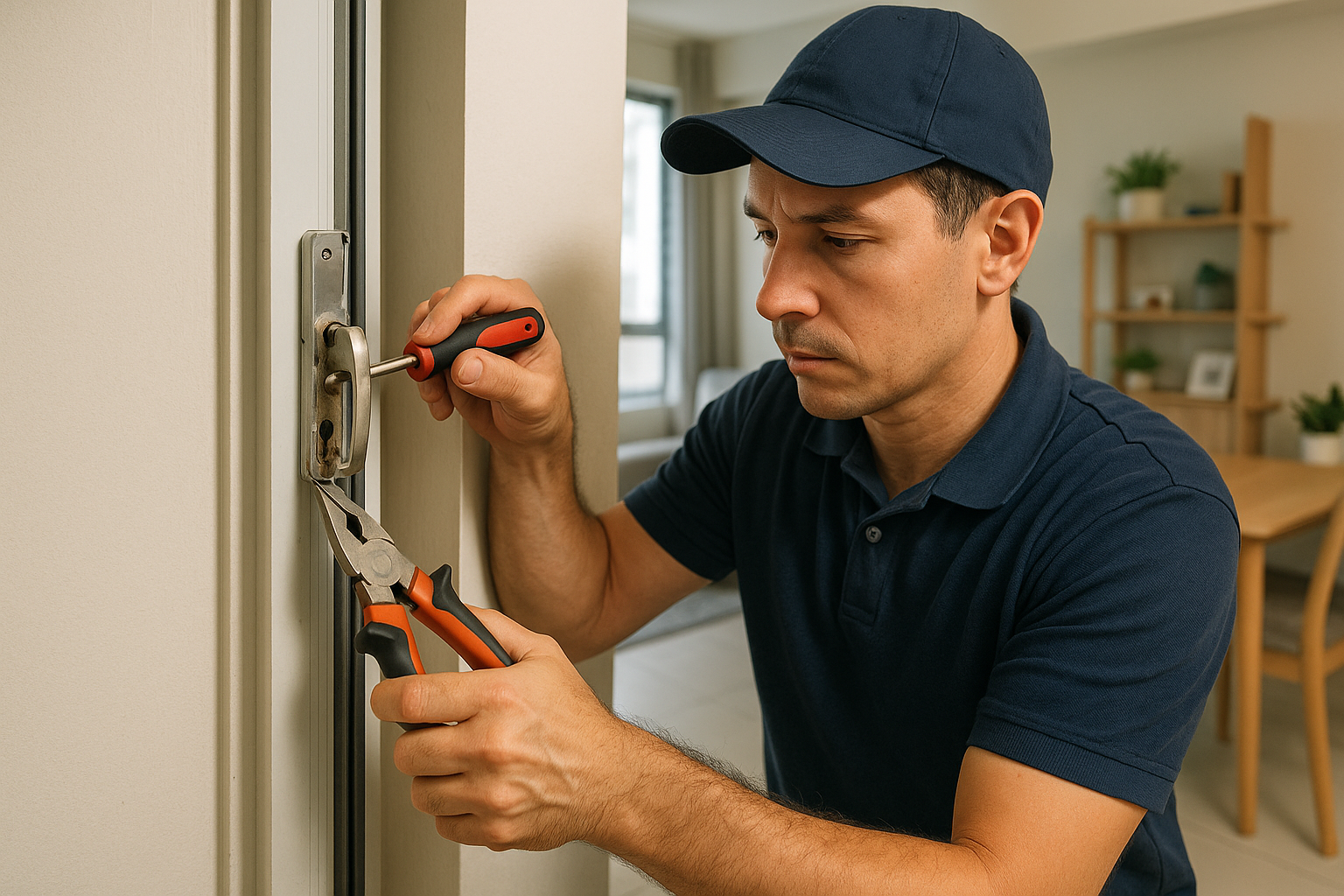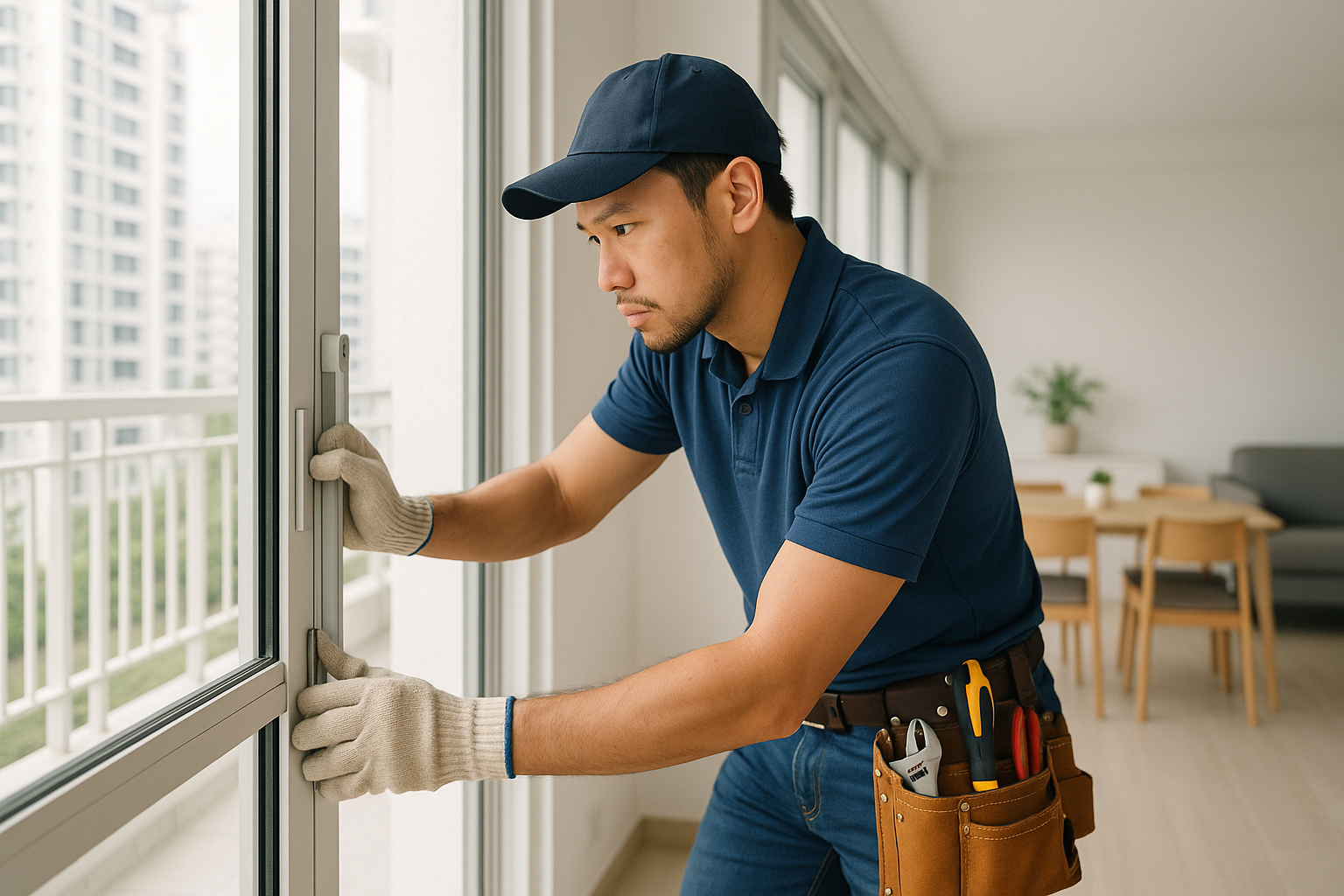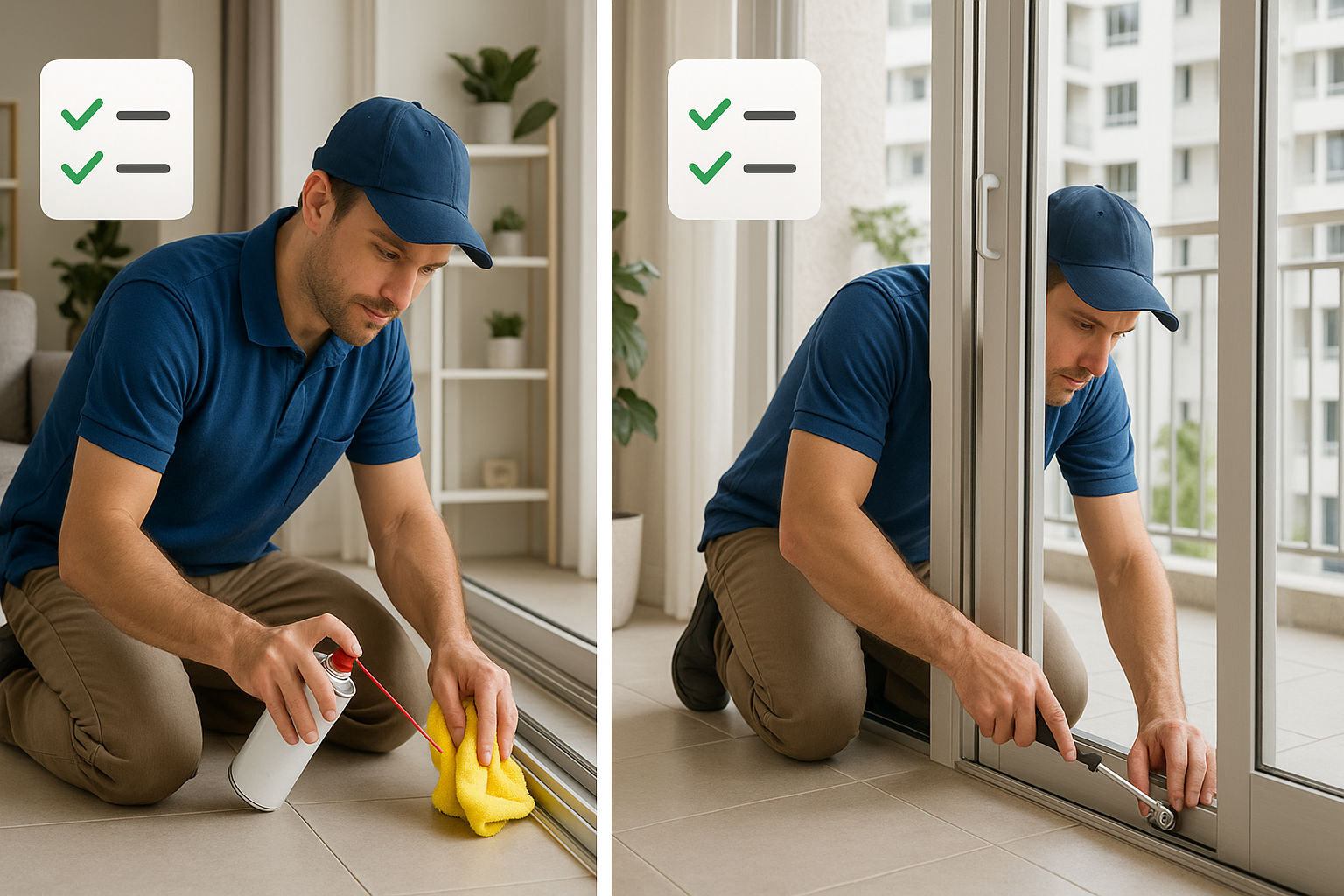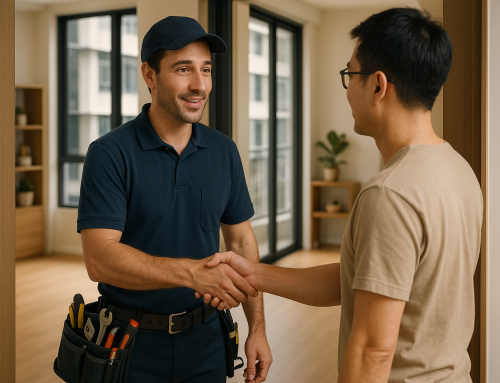Sliding doors are a popular choice in HDB flats in Singapore due to their space-saving design and modern aesthetic. They are widely used for wardrobes, bathrooms, kitchens, and balconies. However, like any frequently used fixture, sliding doors are prone to a variety of problems over time. These issues can cause inconvenience, reduce the lifespan of the doors, and even compromise safety if left unaddressed.
Understanding common sliding door problems and knowing how professional handymen fix them can help homeowners maintain smooth operation and avoid costly repairs. This article explores the most typical issues in HDB sliding doors and provides practical solutions.
 1. Door Tracks Getting Stuck or Jammed
1. Door Tracks Getting Stuck or Jammed
Problem:
Sliding doors rely on smooth tracks to move easily. Over time, dirt, dust, debris, or even small objects can accumulate in the tracks, causing the door to stick or jam. Misalignment of the tracks due to constant use is another common reason.
How We Fix It:
-
Cleaning and Lubrication: The first step is to remove any dirt, grime, or obstacles from the track. A professional handyman uses a soft brush or vacuum to clean thoroughly, followed by applying appropriate lubrication like silicone spray.
-
Track Alignment: If the tracks are misaligned, they are adjusted or realigned to ensure smooth sliding.
-
Replacement if Necessary: Severely bent or damaged tracks may require replacement to restore proper functionality.
Tip for Homeowners: Regularly clean sliding door tracks every few months to prevent debris buildup and avoid jamming.
2. Roller Problems
Problem:
Sliding doors use rollers to glide along tracks. With time, these rollers can wear out, break, or become misaligned. Symptoms include a door that moves unevenly, makes squeaky noises, or comes off the track completely.
How We Fix It:
-
Roller Inspection: The handyman inspects the rollers to check for wear, damage, or misalignment.
-
Replacement of Rollers: Worn-out rollers are replaced with high-quality alternatives to ensure smooth operation.
-
Adjusting Roller Height: Proper alignment ensures the door moves evenly without scraping or sticking.
Maintenance Tip: Avoid slamming doors and check rollers periodically for signs of wear.
3. Door Misalignment or Sagging
Problem:
Over time, sliding doors may sag, tilt, or become misaligned. This is often due to worn-out hinges, screws loosening, or structural issues in the frame. Misaligned doors can cause friction, making it difficult to open or close the door.
How We Fix It:
-
Adjusting the Door Frame: Minor misalignments can be corrected by tightening screws and adjusting the frame.
-
Hinge and Track Adjustment: Rollers and hinges are calibrated to ensure the door hangs evenly and slides smoothly.
-
Professional Assessment: For persistent sagging, a professional may recommend replacing worn parts or reinforcing the frame.
Tip: Avoid forcing a misaligned door, as it can cause further damage.
4. Broken or Damaged Handles
Problem:
Sliding door handles can become loose, break, or even fall off due to frequent use. Without a proper handle, opening and closing the door becomes inconvenient and potentially unsafe.
How We Fix It:
-
Tightening Screws: Loose handles can often be fixed by tightening screws or bolts.
-
Replacing Handles: Damaged handles are replaced with matching or upgraded options for better durability and appearance.
-
Checking for Internal Damage: The handyman checks for hidden damage behind the handle that may affect door operation.
Tip: Handle replacement is a simple yet effective fix to improve usability.
 5. Doors Making Unusual Noises
5. Doors Making Unusual Noises
Problem:
Squeaking, grinding, or rattling sounds are common complaints with sliding doors. These noises usually indicate dirt in the tracks, worn rollers, or insufficient lubrication.
How We Fix It:
-
Cleaning Tracks and Rollers: Dust and debris are removed to reduce friction.
-
Lubrication: High-quality lubricants are applied to tracks and rollers to minimize noise.
-
Replacing Worn Components: Noisy rollers or damaged tracks are replaced to restore smooth, quiet operation.
Maintenance Tip: Regular cleaning and lubrication prevent noise issues and extend the life of the sliding door.
6. Door Coming Off the Track
Problem:
Occasionally, a sliding door may come off its track, making it unusable. This can happen due to worn rollers, misaligned tracks, or excessive force.
How We Fix It:
-
Realigning the Door: The door is carefully lifted back onto the track.
-
Roller and Track Inspection: Any damaged rollers or tracks are repaired or replaced.
-
Safety Check: The handyman ensures that the door operates smoothly and safely after reinstallation.
Tip: Never attempt to force a door back onto the track without inspecting for underlying problems.
7. Cracks or Broken Glass Panels
Problem:
Sliding doors with glass panels can develop cracks or break entirely. This is a safety hazard and must be addressed immediately.
How We Fix It:
-
Glass Replacement: The broken or cracked glass is replaced with tempered safety glass that meets HDB regulations.
-
Frame Inspection: The door frame is checked to ensure it remains stable and secure.
-
Sealing and Finishing: Proper sealing ensures the new glass fits perfectly without rattling or gaps.
Tip: Always use professional services for glass replacement to ensure safety compliance.
8. Door Locks and Security Issues
Problem:
Sliding doors often have locks or latches that can malfunction over time. A faulty lock compromises security and makes the door difficult to use.
How We Fix It:
-
Inspecting Lock Mechanisms: The handyman examines the lock for wear, rust, or misalignment.
-
Repair or Replacement: Broken locks are repaired or replaced with high-quality hardware.
-
Testing Security: The door’s security is tested after repair to ensure reliable locking.
Tip: Regularly check sliding door locks, especially on balcony or bathroom doors, for safety reasons.
9. Preventive Maintenance Tips
Regular maintenance can help prevent sliding door problems in HDB flats:
-
Clean Tracks Monthly: Remove dust, dirt, and small debris.
-
Lubricate Rollers: Use silicone spray or similar lubricant for smooth movement.
-
Inspect Rollers and Handles: Check for wear or looseness every few months.
-
Avoid Slamming Doors: Gentle operation extends the life of rollers and tracks.
-
Professional Inspection: Schedule periodic handyman visits for preventive checks.
 10. Why Hiring a Professional Handyman Matters
10. Why Hiring a Professional Handyman Matters
While some sliding door issues might seem small, professional handyman services offer several advantages:
-
Expertise: Experienced handymen identify root causes and provide long-lasting solutions.
-
Safety: Proper handling of glass and heavy doors prevents accidents.
-
Time-Saving: Repairs are completed efficiently, reducing disruption to your daily routine.
-
Cost-Effective: Professional repair prevents further damage, saving money in the long run.
Conclusion
Sliding doors are a convenient and stylish feature in HDB flats, but they require proper care and timely repairs. Common problems include stuck doors, worn rollers, misalignment, broken handles, unusual noises, glass damage, and lock issues. By understanding these issues and relying on professional handymen, homeowners can ensure their sliding doors operate smoothly, safely, and efficiently.
Regular maintenance, timely repairs, and expert intervention not only extend the lifespan of sliding doors but also improve the overall functionality and security of your home.
SEO Keywords Used: HDB sliding door problems, sliding door repair Singapore, professional handyman Singapore, home maintenance HDB, sliding door issues



